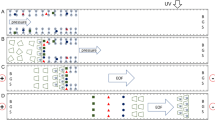Abstract
A novel method has been developed by integration of multi-concentration and two-dimensional (2D) capillary electrophoresis (CE) for simultaneous enhancement of detection sensitivity and separation power in complex samples. Capillary zone electrophoresis (CZE) was used as the first dimension separation according to mobilities, from which the effluent fractions were further analyzed by micellar electrokinetic capillary chromatography (MEKC) acting as the second dimension. Cation-selective exhaustive injection (CSEI) preconcentration method was used to introduce more analytes into the capillary. Furthermore, pH junction and sweeping dual concentration strategies were employed to avoid sample zone diffusion at the interface. The resulting electrophoregram was quite different from that of either CZE or MEKC separation. Up to (0.5–1.2) × 104 fold improvements in sensitivity were obtained relative to the conventional electrokinetic injection method. The proposed method was successfully applied to the determination of drugs in human urine.
Similar content being viewed by others
References
Michels DA, Hu S, Schoenherr RM, Eggertson MJ, Dovichi NJ. Fully automated two-dimensional capillary electrophoresis for high sensitivity protein analysis. Mol Cell Proteomics, 2002, 1: 69–74
Schoenherr RM, Ye M, Vannatta M, Dovichi NJ. CE-microreactor-CE-MS/MS for protein analysis. Anal Chem, 2007, 79: 2230–2238
Mohan D, Lee CS. On-line coupling of capillary isoelectric focusing with transient isotachophoresis-zone electrophoresis: a two-dimensional separation system for proteomics. Electrophoresis, 2002, 23: 3160–3167
Zhang M, El Rassi Z. Two-dimensional microcolumn separation platform for proteomics consisting of on-line coupled capillary isoelectric focusing and capillary electrochromatography. J Proteome Res, 2006, 5: 2001–2008
Anouti S, Vandenabeele-Trambouze O, Koval D, Cottet H. Heartcutting two-dimensional capillary electrophoresis for the on-line purification and separation of derivatized amino acids. Anal Chem, 2008, 80: 1730–1736
Anouti S, Vandenabeele-Trambouze O, Koval D, Cottet H. Heart-cutting 2-D CE using multiple detection points for chiral analysis of native amino acids. Electrophoresis, 2009, 30: 2–10
Yang C, Zhang L, Liu H, Zhang W, Zhang Y. Two-dimensional capillary electrophoresis involving capillary isoelectric focusing and capillary zone electrophoresis. J Chromatogr A, 2003, 1018: 97–103
Yang C, Liu H, Yang Q, Zhang L, Zhang W, Zhang Y. On-line hyphenation of capillary isoelectric focusing and capillary gel electrophoresis by a dialysis interface. Anal Chem, 2003, 75: 215–218
Liu H, Yang C, Yang Q, Zhang W, Zhang Y. On-line combination of capillary isoelectric focusing and capillary non-gel sieving electrophoresis using a hollow-fiber membrane interface: a novel two-dimensional separation system for proteins. J Chromatogr B, 2005, 817: 119–126
Liu H, Zhang L, Zhu G, Zhang W, Zhang Y. An etched porous interface for on-line capillary electrophoresis-based two-dimensional separation system. Anal Chem, 2004, 76: 6506–6512
Gong M, Wehmeyer KR, Limbach PA, Arias F, Heineman WR. On-line sample preconcentration using field-amplified stacking injection in microchip capillary electrophoresis. Anal Chem, 2006, 78: 3730–3737
Fang H, Zeng Z, Liu L. Centrifuge microextraction coupled with on-line back-extraction field-amplified sample injection method for the determination of trace ephedrine derivatives in the urine and serum. Anal Chem, 2006, 78: 6043–6049
Macià A, Borrull F, Aguilar C, Calull M. Improving sensitivity by large-volume sample stacking using the electroosmotic flow pump to analyze some nonsteroidal anti-inflammatory drugs by capillary electrophoresis in water samples. Electrophoresis, 2003, 24: 2779–2787
Quirino JP, Terabe S. Exceeding 5000-fold concentration of dilute analytes in the micellar electrokinetic chromatography. Science, 1998, 282: 465–468
Isoo K, Terabe S. Analysis of metal ions by sweeping via dynamic complexation and cation-selective exhaustive injection in capillary electrophoresis. Anal Chem, 2003, 75: 6789–6798
Britz-McKibbin P, Chen DDY. Selective focusing of catecholamines and weakly acidic compounds by capillary electrophoresis using a dynamic pH junction. Anal Chem, 2000, 72: 1242–1252
Jung B, Bharadwaj R, Santiago JG. On-chip millionfold sample stacking using transient isotachophoresis. Anal Chem, 2006, 78: 2319–2327
Author information
Authors and Affiliations
Corresponding authors
Rights and permissions
About this article
Cite this article
Zhang, Z., Zhang, X. & Li, F. The multi-concentration and two-dimensional capillary electrophoresis method for the analysis of drugs in urine samples. Sci. China Chem. 53, 1183–1189 (2010). https://doi.org/10.1007/s11426-010-0054-7
Received:
Accepted:
Published:
Issue Date:
DOI: https://doi.org/10.1007/s11426-010-0054-7




